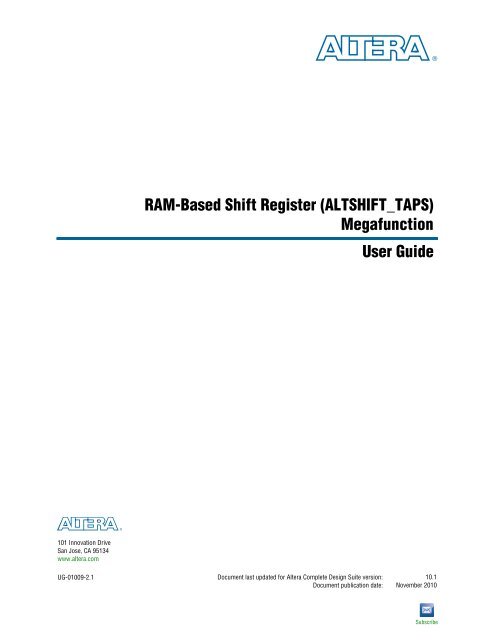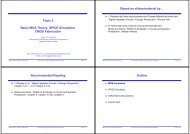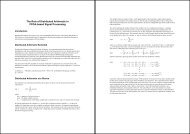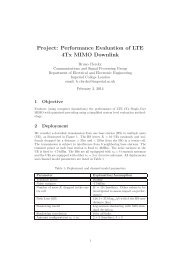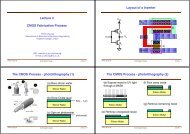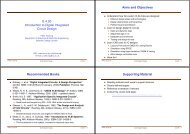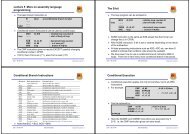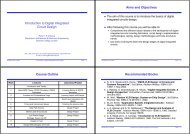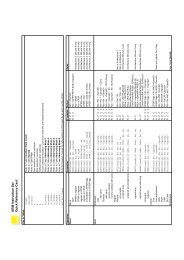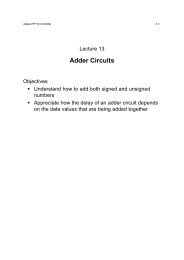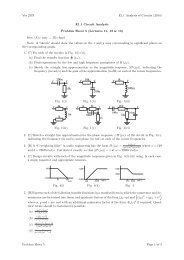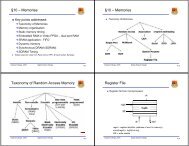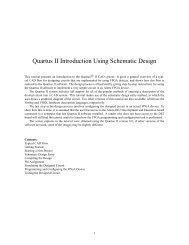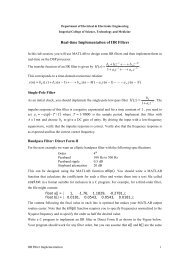RAM-Based Shift Register (ALTSHIFT_TAPS) Megafunction User ...
RAM-Based Shift Register (ALTSHIFT_TAPS) Megafunction User ...
RAM-Based Shift Register (ALTSHIFT_TAPS) Megafunction User ...
You also want an ePaper? Increase the reach of your titles
YUMPU automatically turns print PDFs into web optimized ePapers that Google loves.
<strong>RAM</strong>-<strong>Based</strong> <strong>Shift</strong> <strong>Register</strong> (<strong>ALTSHIFT</strong>_<strong>TAPS</strong>)<br />
<strong>Megafunction</strong> <strong>User</strong> Guide<br />
<strong>RAM</strong>-<strong>Based</strong> <strong>Shift</strong> <strong>Register</strong> (<strong>ALTSHIFT</strong>_<strong>TAPS</strong>)<br />
<strong>Megafunction</strong><br />
<strong>User</strong> Guide<br />
101 Innovation Drive<br />
San Jose, CA 95134<br />
www.altera.com<br />
UG-01009-2.1<br />
Document last updated for Altera Complete Design Suite version:<br />
Document publication date:<br />
10.1<br />
November 2010<br />
Subscribe
© 2010 Altera Corporation. All rights reserved. ALTERA, ARRIA, CYCLONE, HARDCOPY, MAX, MEGACORE, NIOS, QUARTUS and STRATIX are Reg. U.S. Pat.<br />
& Tm. Off. and/or trademarks of Altera Corporation in the U.S. and other countries. All other trademarks and service marks are the property of their respective<br />
holders as described at www.altera.com/common/legal.html. Altera warrants performance of its semiconductor products to current specifications in accordance<br />
with Altera’s standard warranty, but reserves the right to make changes to any products and services at any time without notice. Altera assumes no responsibility or<br />
liability arising out of the application or use of any information, product, or service described herein except as expressly agreed to in writing by Altera. Altera<br />
customers are advised to obtain the latest version of device specifications before relying on any published information and before placing orders for products or<br />
services.<br />
<strong>RAM</strong>-<strong>Based</strong> <strong>Shift</strong> <strong>Register</strong> (<strong>ALTSHIFT</strong>_<strong>TAPS</strong>) <strong>Megafunction</strong> <strong>User</strong> Guide November 2010 Altera Corporation
Contents<br />
Chapter 1. About this <strong>Megafunction</strong><br />
Device Family Support . . . . . . . . . . . . . . . . . . . . . . . . . . . . . . . . . . . . . . . . . . . . . . . . . . . . . . . . . . . . . . . . . . . 1–1<br />
Introduction . . . . . . . . . . . . . . . . . . . . . . . . . . . . . . . . . . . . . . . . . . . . . . . . . . . . . . . . . . . . . . . . . . . . . . . . . . . . 1–1<br />
Features . . . . . . . . . . . . . . . . . . . . . . . . . . . . . . . . . . . . . . . . . . . . . . . . . . . . . . . . . . . . . . . . . . . . . . . . . . . . . . . . 1–2<br />
General Description . . . . . . . . . . . . . . . . . . . . . . . . . . . . . . . . . . . . . . . . . . . . . . . . . . . . . . . . . . . . . . . . . . . . . 1–2<br />
Chapter 2. Getting Started<br />
System Requirements . . . . . . . . . . . . . . . . . . . . . . . . . . . . . . . . . . . . . . . . . . . . . . . . . . . . . . . . . . . . . . . . . . . . 2–1<br />
MegaWizard Plug-In Manager Customization . . . . . . . . . . . . . . . . . . . . . . . . . . . . . . . . . . . . . . . . . . . . . . . 2–1<br />
MegaWizard Plug-In Manager Page Descriptions . . . . . . . . . . . . . . . . . . . . . . . . . . . . . . . . . . . . . . . . . . . . 2–1<br />
Instantiating <strong>Megafunction</strong>s in HDL Code or Schematic Designs . . . . . . . . . . . . . . . . . . . . . . . . . . . . . . 2–6<br />
Generating a Netlist for EDA Tool Use . . . . . . . . . . . . . . . . . . . . . . . . . . . . . . . . . . . . . . . . . . . . . . . . . . . 2–7<br />
Using the Port and Parameter Definitions . . . . . . . . . . . . . . . . . . . . . . . . . . . . . . . . . . . . . . . . . . . . . . . . 2–7<br />
Identifying a <strong>Megafunction</strong> after Compilation . . . . . . . . . . . . . . . . . . . . . . . . . . . . . . . . . . . . . . . . . . . . . . . 2–7<br />
Simulation . . . . . . . . . . . . . . . . . . . . . . . . . . . . . . . . . . . . . . . . . . . . . . . . . . . . . . . . . . . . . . . . . . . . . . . . . . . . . . 2–7<br />
Quartus II Software Simulator . . . . . . . . . . . . . . . . . . . . . . . . . . . . . . . . . . . . . . . . . . . . . . . . . . . . . . . . . . 2–8<br />
EDA Simulator . . . . . . . . . . . . . . . . . . . . . . . . . . . . . . . . . . . . . . . . . . . . . . . . . . . . . . . . . . . . . . . . . . . . . . . 2–8<br />
Design Example: <strong>Shift</strong> <strong>Register</strong> with Taps . . . . . . . . . . . . . . . . . . . . . . . . . . . . . . . . . . . . . . . . . . . . . . . . . . . 2–8<br />
Design Files . . . . . . . . . . . . . . . . . . . . . . . . . . . . . . . . . . . . . . . . . . . . . . . . . . . . . . . . . . . . . . . . . . . . . . . . . . 2–8<br />
Configuration Settings . . . . . . . . . . . . . . . . . . . . . . . . . . . . . . . . . . . . . . . . . . . . . . . . . . . . . . . . . . . . . . . . . 2–9<br />
Functional Simulation in the ModelSim-Altera Simulator . . . . . . . . . . . . . . . . . . . . . . . . . . . . . . . . . . . 2–9<br />
Understanding the Simulation Results . . . . . . . . . . . . . . . . . . . . . . . . . . . . . . . . . . . . . . . . . . . . . . . . . . 2–10<br />
Conclusion . . . . . . . . . . . . . . . . . . . . . . . . . . . . . . . . . . . . . . . . . . . . . . . . . . . . . . . . . . . . . . . . . . . . . . . . . . . . 2–13<br />
Chapter 3. Specifications<br />
Verilog HDL Prototype for the <strong>ALTSHIFT</strong>_<strong>TAPS</strong> <strong>Megafunction</strong> . . . . . . . . . . . . . . . . . . . . . . . . . . . . . . . 3–1<br />
VHDL Component Declaration for the <strong>ALTSHIFT</strong>_<strong>TAPS</strong> <strong>Megafunction</strong> . . . . . . . . . . . . . . . . . . . . . . . . 3–1<br />
VHDL Library-Use Declaration . . . . . . . . . . . . . . . . . . . . . . . . . . . . . . . . . . . . . . . . . . . . . . . . . . . . . . . . . . . 3–2<br />
Ports and Parameters for the <strong>ALTSHIFT</strong>_<strong>TAPS</strong> <strong>Megafunction</strong> . . . . . . . . . . . . . . . . . . . . . . . . . . . . . . . . . 3–2<br />
Additional Information<br />
Document Revision History . . . . . . . . . . . . . . . . . . . . . . . . . . . . . . . . . . . . . . . . . . . . . . . . . . . . . . . . . . . Info–1<br />
How to Contact Altera . . . . . . . . . . . . . . . . . . . . . . . . . . . . . . . . . . . . . . . . . . . . . . . . . . . . . . . . . . . . . . . . Info–1<br />
Typographic Conventions . . . . . . . . . . . . . . . . . . . . . . . . . . . . . . . . . . . . . . . . . . . . . . . . . . . . . . . . . . . . . Info–2<br />
November 2010 Altera Corporation <strong>RAM</strong>-<strong>Based</strong> <strong>Shift</strong> <strong>Register</strong> (<strong>ALTSHIFT</strong>_<strong>TAPS</strong>) <strong>Megafunction</strong> <strong>User</strong> Guide
1. About this <strong>Megafunction</strong><br />
Device Family Support<br />
The <strong>ALTSHIFT</strong>_<strong>TAPS</strong> megafunction supports the following target Altera ® device<br />
families:<br />
■<br />
■<br />
■<br />
■<br />
■<br />
Arria ® GX<br />
Cyclone ® III<br />
Cyclone II<br />
Cyclone<br />
HardCopy ® II<br />
■ HardCopy Stratix ®<br />
■<br />
■<br />
■<br />
■<br />
■<br />
■<br />
■<br />
■<br />
■<br />
■<br />
■<br />
■<br />
■<br />
Stratix IV<br />
Stratix III<br />
Stratix II<br />
Stratix II GX<br />
Stratix<br />
Stratix GX<br />
ACEX ® 1K<br />
APEX II<br />
APEX 20KC<br />
APEX 20KE<br />
FLEX ® 10K<br />
FLEX 10KA<br />
FLEX 10KE<br />
Introduction<br />
As design complexities increase, the use of vendor-specific IP blocks has become a<br />
common design methodology. Altera provides parameterizable megafunctions that<br />
are optimized for Altera device architectures. Using megafunctions instead of coding<br />
your own logic saves valuable design time. Additionally, the Altera-provided<br />
functions may offer more efficient logic synthesis and device implementation. You can<br />
scale the megafunction’s size by simply setting parameters.<br />
November 2010 Altera Corporation <strong>RAM</strong>-<strong>Based</strong> <strong>Shift</strong> <strong>Register</strong> (<strong>ALTSHIFT</strong>_<strong>TAPS</strong>) <strong>Megafunction</strong> <strong>User</strong> Guide
1–2 Chapter 1: About this <strong>Megafunction</strong><br />
Features<br />
Altera provides a <strong>RAM</strong>-based shift register megafunction called <strong>ALTSHIFT</strong>_<strong>TAPS</strong><br />
that contains additional features not found in a conventional shift register. Traditional<br />
shift registers implemented with standard flip-flops use many logic cells for large<br />
shift registers. The <strong>ALTSHIFT</strong>_<strong>TAPS</strong> megafunction is implemented in the device<br />
memory blocks, saving logic cells and routing resources. In a complicated design such<br />
as a digital signal processing (DSP) application that requires local data storage, it is<br />
more efficient to implement an <strong>ALTSHIFT</strong>_<strong>TAPS</strong> megafunction as the shift register.<br />
The <strong>ALTSHIFT</strong>_<strong>TAPS</strong> megafunction is a parameterized shift register with taps. The<br />
taps provide data outputs from the shift register at certain points in the shift register<br />
chain. You can add additional logic that uses the output from these taps for further<br />
applications. The megafunction’s output tap feature is useful for applications such as<br />
the Linear Feedback <strong>Shift</strong> <strong>Register</strong> (LFSR) and Finite Impulse Response (FIR) filters.<br />
Features<br />
The <strong>ALTSHIFT</strong>_<strong>TAPS</strong> megafunction implements a shift register with taps and offers<br />
additional features, which include:<br />
■<br />
■<br />
■<br />
■<br />
Selectable <strong>RAM</strong> block type<br />
A wide range of widths for the shiftin and shiftout ports<br />
Support for output taps at certain points in the shift register chain<br />
Selectable distance between taps<br />
General Description<br />
The <strong>ALTSHIFT</strong>_<strong>TAPS</strong> megafunction can be easily configured and built through the<br />
<strong>Shift</strong> <strong>Register</strong> (<strong>RAM</strong>-based) MegaWizard ® Plug-In Manager in the Quartus ® II<br />
software.<br />
Chapter 2, Getting Started guides you through each page of the MegaWizard Plug-In<br />
Manager with explanations for each of the options.<br />
The <strong>ALTSHIFT</strong>_<strong>TAPS</strong> megafunction is implemented in the embedded memory block<br />
of all supported device families with simple dual-port <strong>RAM</strong>. You can select the <strong>RAM</strong><br />
block type according to the capacity you require. The capacity that is represented by<br />
the width and the depth of the memory block depends on the TAP_DISTANCE,<br />
NUMBER_OF_<strong>TAPS</strong>, and WIDTH parameters of the <strong>ALTSHIFT</strong>_<strong>TAPS</strong> megafunction.<br />
f<br />
For the features and capacities of the typical memory block, refer to the chapter of<br />
your device handbook that contains information about TriMatrix embedded memory<br />
blocks.<br />
The <strong>ALTSHIFT</strong>_<strong>TAPS</strong> megafunction supports single-bit and multiple-bit data shifting<br />
at one clock cycle, depending on the width of the shiftin and shiftout ports. For<br />
example, if the shiftin and shiftout ports are single-bit data, only one bit is shifted<br />
per clock cycle. If the shiftin and shiftout ports are multiple-bit data, such as oneword<br />
data (8-bit), the whole word is shifted per clock cycle.<br />
The megafunction also supports output taps at certain points in the shift register<br />
chain, but the tap points must be evenly spaced. The space between taps is set by the<br />
TAP_DISTANCE parameter in the MegaWizard Plug-in Manager.<br />
<strong>RAM</strong>-<strong>Based</strong> <strong>Shift</strong> <strong>Register</strong> (<strong>ALTSHIFT</strong>_<strong>TAPS</strong>) <strong>Megafunction</strong> <strong>User</strong> Guide November 2010 Altera Corporation
Chapter 1: About this <strong>Megafunction</strong> 1–3<br />
General Description<br />
f<br />
For more information about setting the option for the distance between taps in the<br />
MegaWizard Plug-in Manager, refer to Chapter 2, Getting Started. For information<br />
about the TAP_DISTANCE parameter, refer to Chapter 3, Specifications.<br />
Figure (a) in Figure 1–1 shows a traditional 12-word-depth shift register. Figure (b)<br />
shows how the data in the shift register chain are being tapped at even spaces (1st,<br />
4th, 7th, and 10th) at the output taps of the <strong>ALTSHIFT</strong>_<strong>TAPS</strong> megafunction.<br />
Figure 1–1. Tapping Data at Certain Points of the <strong>Shift</strong> <strong>Register</strong> Chain (Note 1), (2), (3)<br />
Notes for Figure 1–1<br />
(1) The <strong>ALTSHIFT</strong>_<strong>TAPS</strong> megafunction depicted here has TAP_DISTANCE = 3 and NUMBER_OF_<strong>TAPS</strong> = 4.<br />
(2) The tapped data is output to taps[31..0]. Note that taps[31..0] is a 32-bit output because it taps four words at one time. The first word from<br />
the MSB of the taps (taps[31..24]) represents the first data and is followed by the 4th data, 7th data, and 10th data.<br />
(3) The shiftout[7..0] word is equivalent to taps[31..24].<br />
November 2010 Altera Corporation <strong>RAM</strong>-<strong>Based</strong> <strong>Shift</strong> <strong>Register</strong> (<strong>ALTSHIFT</strong>_<strong>TAPS</strong>) <strong>Megafunction</strong> <strong>User</strong> Guide
2. Getting Started<br />
System Requirements<br />
The instructions in this section require the following software:<br />
■<br />
■<br />
The Quartus ® II software version 8.0 or later<br />
For operating system support information, refer to<br />
www.altera.com/support/software/os_support/oss-index.html<br />
MegaWizard Plug-In Manager Customization<br />
The MegaWizard ® Plug-In Manager creates or modifies design files that contain<br />
custom megafunction variations, which can then be instantiated in a design file. The<br />
MegaWizard Plug-In Manager provides a wizard that allows you to specify options<br />
for the <strong>ALTSHIFT</strong>_<strong>TAPS</strong> megafunction features in your design.<br />
Start the MegaWizard Plug-In Manager in one of the following ways:<br />
■<br />
■<br />
■<br />
On the Tools menu, click MegaWizard Plug-In Manager.<br />
In the Block Editor, on the Edit menu, click Insert Symbol as Block, or right-click<br />
in the Block Editor, point to Insert, and click Symbol as Block. In the Symbol<br />
window, click MegaWizard Plug-In Manager.<br />
Start the stand-alone version of the MegaWizard Plug-In Manager by typing the<br />
following command at the command prompt:<br />
qmegawizr<br />
MegaWizard Plug-In Manager Page Descriptions<br />
This section provides descriptions for the options available on the individual pages of<br />
the <strong>Shift</strong> <strong>Register</strong> (<strong>RAM</strong>-based) MegaWizard plug-in.<br />
On page 1 of the MegaWizard Plug-In Manager, you can select Create a new custom<br />
megafunction variation, Edit an existing custom megafunction variation, or Copy<br />
an existing custom megafunction variation (Figure 2–1).<br />
Figure 2–1. MegaWizard Plug-In Manager [page 1]<br />
November 2010 Altera Corporation <strong>RAM</strong>-<strong>Based</strong> <strong>Shift</strong> <strong>Register</strong> (<strong>ALTSHIFT</strong>_<strong>TAPS</strong>) <strong>Megafunction</strong> <strong>User</strong> Guide
2–2 Chapter 2: Getting Started<br />
MegaWizard Plug-In Manager Page Descriptions<br />
On page 2a of the MegaWizard Plug-In Manager, specify the megafunction, device<br />
family to use, type of output file to create, and the name of the output file (Figure 2–2).<br />
Choose AHDL (.tdf), VHDL (.vhd), or Verilog HDL (.v) as the output file type.<br />
Figure 2–2. MegaWizard Plug-In Manager [page 2a]<br />
<strong>RAM</strong>-<strong>Based</strong> <strong>Shift</strong> <strong>Register</strong> (<strong>ALTSHIFT</strong>_<strong>TAPS</strong>) <strong>Megafunction</strong> <strong>User</strong> Guide November 2010 Altera Corporation
Chapter 2: Getting Started 2–3<br />
MegaWizard Plug-In Manager Page Descriptions<br />
On page 3 of the MegaWizard Plug-In Manager, specify the width of the shiftin<br />
input bus and the shiftout output bus, specify the number of taps, create groups for<br />
each tap output, and specify the distance between the taps. You can also create a<br />
clock-enable port and an asynchronous-clear port, if applicable to your design, and<br />
select the type of <strong>RAM</strong> block type to use (Figure 2–3).<br />
Figure 2–3. MegaWizard Plug-In Manager – <strong>Shift</strong> <strong>Register</strong> (<strong>RAM</strong>-based) [page 3 of 5]<br />
1 Starting on page 3 of the <strong>Shift</strong> <strong>Register</strong> (<strong>RAM</strong>-based) MegaWizard Plug-In Manager,<br />
you can launch the <strong>Shift</strong> <strong>Register</strong> (<strong>RAM</strong>-based) (<strong>ALTSHIFT</strong>_<strong>TAPS</strong>) <strong>Megafunction</strong> <strong>User</strong><br />
Guide, the <strong>ALTSHIFT</strong>_<strong>TAPS</strong> megafunction online help, or generate sample waveforms<br />
by clicking the Documentation button.<br />
Table 2–1 shows the options available on page 3 of the <strong>Shift</strong> <strong>Register</strong> (<strong>RAM</strong>-based)<br />
MegaWizard Plug-In Manager. Use this table, along with the hardware descriptions,<br />
to determine the appropriate settings for the features.<br />
Table 2–1. <strong>Shift</strong> <strong>Register</strong> (<strong>RAM</strong>-based) MegaWizard Plug-in Manager [page 3] Options (Part 1 of 2)<br />
Configuration Setting<br />
How wide should the ‘shiftin’ input and the ‘shiftout’<br />
output buses be<br />
How many taps would you like<br />
Create groups for each tap output<br />
How wide should the distance between taps be<br />
Description<br />
Specify the width of the data input and output buses. This<br />
value is represented by the term w in the <strong>Shift</strong> <strong>Register</strong><br />
Memory Configuration shown in Figure 2–4. (1)<br />
Specify the number of taps. This value is represented by the<br />
term n in the <strong>Shift</strong> <strong>Register</strong> Memory Configuration shown in<br />
Figure 2–4. (2)<br />
Turn on this option to create separate groups for output data<br />
tapped from the register chain. (3)<br />
Specify the distance between taps. This value is represented<br />
by the term m in the <strong>Shift</strong> <strong>Register</strong> Memory Configuration<br />
shown in Figure 2–4. (4)<br />
November 2010 Altera Corporation <strong>RAM</strong>-<strong>Based</strong> <strong>Shift</strong> <strong>Register</strong> (<strong>ALTSHIFT</strong>_<strong>TAPS</strong>) <strong>Megafunction</strong> <strong>User</strong> Guide
2–4 Chapter 2: Getting Started<br />
MegaWizard Plug-In Manager Page Descriptions<br />
Table 2–1. <strong>Shift</strong> <strong>Register</strong> (<strong>RAM</strong>-based) MegaWizard Plug-in Manager [page 3] Options (Part 2 of 2)<br />
Configuration Setting<br />
Create a clock enable port<br />
Create an asynchronous clear port<br />
What should the <strong>RAM</strong> block type be<br />
Description<br />
Turn on this option to create an enable signal for register<br />
ports. The register ports are always enabled if this option is<br />
not turned on. (5)<br />
Turn on this option to create an asynchronous clear signal.<br />
When asserted, the outputs of the shift register are<br />
immediately cleared.<br />
Choose the type of memory block that supports the feature,<br />
memory configuration, and capacity for your application.<br />
(6)<br />
Notes for Table 2–1<br />
(1) The widths of the shiftin input bus and shiftout output bus are identical, and they are not registered. However, the output data can be<br />
considered synchronous with the clock because the internal read address to the memory block is synchronous to the clock.<br />
(2) The width of the output taps is the multiplication of w (width of input data) and n (number of taps). Also, the word from the MSB of the output<br />
taps is equivalent to the shiftout output bus.<br />
(3) The combination of these groups represent the taps[wn-1:0] bus.<br />
(4) The distance between taps, m, must be at least 3.<br />
(5) The registered port is referred to as the internal register at the memory address ports. The shiftin and shiftout ports are not registered.<br />
(6) For information about the chosen memory block type, refer to the TriMatrix Embedded Memory Block chapter of your target device handbook.<br />
You can also choose AUTO if you are not particular about the <strong>RAM</strong> block type used. With the AUTO option, the memory block type is determined<br />
by the Quartus II software synthesizer or Fitter at compile time. To determine the type of memory block used, check the Quartus II Fitter Report.<br />
Figure 2–4 shows an example of a shift register chain.<br />
Figure 2–4. <strong>Shift</strong> <strong>Register</strong> Chain Example<br />
<strong>RAM</strong>-<strong>Based</strong> <strong>Shift</strong> <strong>Register</strong> (<strong>ALTSHIFT</strong>_<strong>TAPS</strong>) <strong>Megafunction</strong> <strong>User</strong> Guide November 2010 Altera Corporation
Chapter 2: Getting Started 2–5<br />
MegaWizard Plug-In Manager Page Descriptions<br />
Page 4 of the <strong>Shift</strong> <strong>Register</strong> (<strong>RAM</strong>-based) MegaWizard Plug-In Manager lists the files<br />
needed to properly simulate the generated design files (Figure 2–5).<br />
Figure 2–5. MegaWizard Plug-In Manager – <strong>Shift</strong> <strong>Register</strong> (<strong>RAM</strong>-based) [page 4 of 5]<br />
Page 5 of the <strong>Shift</strong> <strong>Register</strong> (<strong>RAM</strong>-based) MegaWizard Plug-In Manager displays the<br />
types of files to be generated. The Variation file, which is automatically generated,<br />
contains wrapper code in the language you specified on page 2a. On page 5 of the<br />
MegaWizard Plug-In Manager, specify the types of files to be generated. You can<br />
choose from the following types of files:<br />
■<br />
■<br />
■<br />
■<br />
■<br />
AHDL Include file (.inc)<br />
VHDL component declaration file (.cmp)<br />
Quartus II symbol file (.bsf)<br />
Instantiation template file (_inst.v)<br />
Verilog HDL black-box file (_bb.v)<br />
November 2010 Altera Corporation <strong>RAM</strong>-<strong>Based</strong> <strong>Shift</strong> <strong>Register</strong> (<strong>ALTSHIFT</strong>_<strong>TAPS</strong>) <strong>Megafunction</strong> <strong>User</strong> Guide
2–6 Chapter 2: Getting Started<br />
Instantiating <strong>Megafunction</strong>s in HDL Code or Schematic Designs<br />
If you selected Generate netlist on page 4 of the MegaWizard Plug-In Manager, the<br />
file for that netlist is also available. A gray checkmark indicates a file that is<br />
automatically generated and a red checkmark indicates an optional file (Figure 2–6).<br />
Figure 2–6. MegaWizard Plug-In Manager - <strong>Shift</strong> <strong>Register</strong> (<strong>RAM</strong>-based) [page 5 of 5]<br />
Instantiating <strong>Megafunction</strong>s in HDL Code or Schematic Designs<br />
When you use the MegaWizard Plug-In Manager to customize and parameterize a<br />
megafunction, it creates a set of output files that allows you to instantiate the<br />
customized function in your design. Depending on the language you choose in the<br />
MegaWizard Plug-In Manager, the wizard instantiates the megafunction with the<br />
correct parameter values and generates a megafunction variation file (wrapper file) in<br />
Verilog HDL (.v), VHDL (.vhd), or AHDL (.tdf), along with other supporting files.<br />
The MegaWizard Plug-In Manager provides options to create the following files:<br />
■<br />
■<br />
■<br />
■<br />
■<br />
A sample instantiation template for the language of the variation file (_inst.v,<br />
_inst.vhd, or inst.tdf)<br />
Component Declaration File (.cmp) that can be used in VHDL Design Files<br />
AHDL Include File (.inc) that can be used in Text Design Files (.tdf)<br />
Quartus II Block Symbol File (.bsf) that can be used in schematic designs<br />
Verilog HDL module declaration file that can be used when instantiating the<br />
megafunction as a black box in a third-party synthesis tool (_bb.v)<br />
<strong>RAM</strong>-<strong>Based</strong> <strong>Shift</strong> <strong>Register</strong> (<strong>ALTSHIFT</strong>_<strong>TAPS</strong>) <strong>Megafunction</strong> <strong>User</strong> Guide November 2010 Altera Corporation
Chapter 2: Getting Started 2–7<br />
Identifying a <strong>Megafunction</strong> after Compilation<br />
f<br />
For more information about the wizard-generated files, refer to the Quartus II Help or<br />
to the Recommended HDL Coding Styles chapter in volume 1 of the Quartus II Handbook.<br />
Generating a Netlist for EDA Tool Use<br />
If you use a third-party EDA synthesis tool, you can instantiate the megafunction<br />
variation file as a black box for synthesis. Use the VHDL component declaration or<br />
Verilog HDL module declaration black-box file to define the function in your<br />
synthesis tool, and then include the megafunction variation file in your Quartus II<br />
project.<br />
If you enable the option to generate a synthesis area and timing estimation netlist in<br />
the MegaWizard Plug-In Manager, the wizard generates an additional netlist file<br />
(_syn.v). The netlist file is a representation of the customized logic used in the<br />
Quartus II software. The file provides the connectivity of the architectural elements in<br />
the megafunction but may not represent the true functionality. This information<br />
enables certain third-party synthesis tools to better report area and timing estimates.<br />
In addition, synthesis tools can use the timing information to focus timing-driven<br />
optimizations and improve the quality of results.<br />
f<br />
For more information about using megafunctions in your third-party synthesis tool,<br />
refer to the appropriate chapter in the Synthesis section in volume 1 of the Quartus II<br />
Handbook.<br />
Using the Port and Parameter Definitions<br />
Instead of using the MegaWizard Plug-In Manager, you can instantiate the<br />
megafunction directly in your Verilog HDL, VHDL, or AHDL code by calling the<br />
megafunction and setting its parameters as you would any other module, component,<br />
or subdesign.<br />
1 Altera strongly recommends that you use the MegaWizard Plug-In Manager for<br />
complex megafunctions. The MegaWizard Plug-In Manager ensures that you set all<br />
megafunction parameters properly.<br />
f<br />
For a list of the megafunction ports and parameters, refer to Chapter 3, Specifications.<br />
Identifying a <strong>Megafunction</strong> after Compilation<br />
During compilation with the Quartus II software, analysis and elaboration are<br />
performed to build the structure of your design. You can locate your megafunction in<br />
the Project Navigator window by expanding the compilation hierarchy and locating<br />
the megafunction by its name.<br />
To search for node names within the megafunction (using the Node Finder), click<br />
Browse in the Look in box and select the megafunction in the Hierarchy box.<br />
Simulation<br />
The Quartus II Simulator provides an easy-to-use, integrated solution for performing<br />
simulations. The following sections describe the simulation options.<br />
November 2010 Altera Corporation <strong>RAM</strong>-<strong>Based</strong> <strong>Shift</strong> <strong>Register</strong> (<strong>ALTSHIFT</strong>_<strong>TAPS</strong>) <strong>Megafunction</strong> <strong>User</strong> Guide
2–8 Chapter 2: Getting Started<br />
Design Example: <strong>Shift</strong> <strong>Register</strong> with Taps<br />
Quartus II Software Simulator<br />
With the Quartus II Simulator, you can perform two types of simulations: functional<br />
and timing. A functional simulation enables you to verify the logical operation of<br />
your design without taking into consideration the timing delays in the FPGA. This<br />
simulation is performed using only your RTL code. When performing a functional<br />
simulation, add only signals that exist before synthesis. You can find these signals in<br />
the Node Finder by using any of the following Filter options: <strong>Register</strong>s: pre-synthesis,<br />
Design Entry, or Pins. The top-level ports of megafunctions are found using these<br />
three filters.<br />
In contrast, timing simulation in the Quartus II software verifies the operation of your<br />
design with annotated timing information. This simulation is performed using the<br />
post-place-and-route netlist. When performing a timing simulation, add only signals<br />
that exist after place-and-route. These signals are found with the post-compilation<br />
filter of the Node Finder. During synthesis and place-and-route, the names of the RTL<br />
signals change. Therefore, it may be difficult to find signals from your megafunction<br />
instantiation in the post-compilation filter.<br />
To preserve the names of your signals during the synthesis and place-and-route<br />
stages, use the synthesis attributes keep or preserve. These are Verilog HDL and<br />
VHDL synthesis attributes that direct analysis and synthesis to keep a particular wire,<br />
register, or node intact. Use these synthesis attributes to keep a combinational logic<br />
node so you can observe the node during simulation.<br />
f<br />
For more information about these attributes, refer to the Quartus II Integrated Synthesis<br />
chapter in volume 1 of the Quartus II Handbook.<br />
EDA Simulator<br />
The Quartus II Handbook chapters describe how to perform functional and gate-level<br />
timing simulations that include the megafunctions, with details about the files that are<br />
needed and the directories where the files are located.<br />
f<br />
Depending on which simulation tool you are using, refer to the appropriate chapter in<br />
the Simulation section in volume 3 of the Quartus II Handbook.<br />
Design Example: <strong>Shift</strong> <strong>Register</strong> with Taps<br />
Design Files<br />
The objective of this design example is to implement and instantiate an<br />
<strong>ALTSHIFT</strong>_<strong>TAPS</strong> megafunction built through the <strong>Shift</strong> <strong>Register</strong> (<strong>RAM</strong>-<strong>Based</strong>)<br />
MegaWizard Plug-In Manager. This example uses a shift register with a data width, w,<br />
of 8 bits, a taps distance, m, of 3, and the number of taps, n, equal to 4. It also<br />
demonstrates how you can tap the data at specific points from the shift register chain.<br />
The example design files are available in the <strong>User</strong> Guides section on the Literature<br />
page of the Altera ® website (www.altera.com).<br />
<strong>RAM</strong>-<strong>Based</strong> <strong>Shift</strong> <strong>Register</strong> (<strong>ALTSHIFT</strong>_<strong>TAPS</strong>) <strong>Megafunction</strong> <strong>User</strong> Guide November 2010 Altera Corporation
Chapter 2: Getting Started 2–9<br />
Design Example: <strong>Shift</strong> <strong>Register</strong> with Taps<br />
Configuration Settings<br />
In page 3 of the <strong>Shift</strong> <strong>Register</strong> (<strong>RAM</strong>-based) MegaWizard Plug-In Manager, select or<br />
verify the configuration settings shown in Table 2–2. Click Next to advance to the next<br />
page.<br />
Table 2–2. <strong>Shift</strong> <strong>Register</strong> (<strong>RAM</strong>-<strong>Based</strong>) MegaWizard Plug-In Manager Configuration Settings<br />
Configuration Setting<br />
Currently selected device family<br />
Stratix III<br />
How wide should the ‘shiftin’ input and the ‘shiftout’<br />
output buses be<br />
8 bits<br />
How many taps would you like 4<br />
Create groups for each tap output<br />
Selected<br />
How wide should the distance between taps be 3<br />
Create a clock enable port<br />
Selected<br />
Create an asynchronous clear port<br />
Selected<br />
What should the <strong>RAM</strong> block type be<br />
Auto<br />
Value<br />
Functional Simulation in the ModelSim-Altera Simulator<br />
Simulate the design in the ModelSim ® -Altera software to generate a waveform<br />
display of the device behavior.<br />
You should be familiar with the ModelSim-Altera software before trying the design<br />
example. If you are unfamiliar with the ModelSim-Altera software, refer to the<br />
support page for software products on the Altera website (www.altera.com). On the<br />
support page, there are links to such topics as installation, usage, and troubleshooting.<br />
Set up and simulate the design in the ModelSim-Altera software by performing the<br />
following steps.<br />
1. Unzip the DE_<strong>ALTSHIFT</strong>_<strong>TAPS</strong>.zip file to any working directory on your PC.<br />
2. Start the ModelSim-Altera software.<br />
3. On the File menu, click Change Directory.<br />
4. Select the folder in which you unzipped the files.<br />
5. Click OK.<br />
6. On the Tools menu, click Execute Macro.<br />
7. Select the DE_<strong>ALTSHIFT</strong>_<strong>TAPS</strong>.do file and click Open. The<br />
DE_<strong>ALTSHIFT</strong>_<strong>TAPS</strong>.do file is a script file for the ModelSim-Altera software to<br />
automate all the necessary settings for the simulation.<br />
November 2010 Altera Corporation <strong>RAM</strong>-<strong>Based</strong> <strong>Shift</strong> <strong>Register</strong> (<strong>ALTSHIFT</strong>_<strong>TAPS</strong>) <strong>Megafunction</strong> <strong>User</strong> Guide
2–10 Chapter 2: Getting Started<br />
Design Example: <strong>Shift</strong> <strong>Register</strong> with Taps<br />
View the simulation results in the Wave window. Figure 2–7 shows the expected<br />
simulation results in the ModelSim-Altera software.<br />
Figure 2–7. Simulation Waveform for <strong>Shift</strong> <strong>Register</strong> with Taps Design Example<br />
Understanding the Simulation Results<br />
In this example, you configured the shift register to have the following properties:<br />
■<br />
8-bit data width<br />
■ Distance between taps (taps length) equals to 3<br />
■ Number of taps equals to 4<br />
■<br />
■<br />
Created groups for each tap output<br />
Created a clock-enable signal and an asynchronous-clear signal<br />
This example shows how you can tap the 1st-4th-7th-10th data words simultaneously<br />
(followed by the 2nd-5th-8th-11th and 3rd-6th-9th-12th) when all 12 words of data are<br />
shifted into the shift register.<br />
Figure 2–8 shows the shift register chain that is analogous to the configuration you set<br />
in the <strong>ALTSHIFT</strong>_<strong>TAPS</strong> megafunction in this example.<br />
Figure 2–8. <strong>Shift</strong> <strong>Register</strong> Chain Analogy to the Configured <strong>ALTSHIFT</strong>_<strong>TAPS</strong> <strong>Megafunction</strong><br />
The next section uses this shift register chain to explain the shifting operation and the<br />
output operation of the <strong>ALTSHIFT</strong>_<strong>TAPS</strong> megafunction.<br />
<strong>RAM</strong>-<strong>Based</strong> <strong>Shift</strong> <strong>Register</strong> (<strong>ALTSHIFT</strong>_<strong>TAPS</strong>) <strong>Megafunction</strong> <strong>User</strong> Guide November 2010 Altera Corporation
Chapter 2: Getting Started 2–11<br />
Design Example: <strong>Shift</strong> <strong>Register</strong> with Taps<br />
Figure 2–9 shows the first three data words written into the shift register chain, shifted<br />
in the register chain, and the first data shown at the taps0x output.<br />
Figure 2–9. First Three Data Written and <strong>Shift</strong>ed in the <strong>Shift</strong> <strong>Register</strong><br />
At 5 ns, the clken signal is low and therefore no operation is executed. You can<br />
consider 15 ns to be the first rising clock edge, as this is when the operation begins.<br />
The first data F8 is shifted into the shift register as shown in Figure 2–10. All outputs<br />
show 00 because no data is being shifted to any of the outputs.<br />
Figure 2–10. Content of the <strong>Shift</strong> <strong>Register</strong> Chain at 15 ns<br />
At 25 ns and 35 ns, the second data B8 and the third data D0 are shifted into the shift<br />
register, respectively.<br />
1 The existing data in the shift register chain are shifted right before the shift-in of new<br />
data.<br />
Figure 2–11 shows the content in the shift register chain at 35 ns. All of the outputs<br />
show 00 except taps0x, which shows the first data, F8.<br />
November 2010 Altera Corporation <strong>RAM</strong>-<strong>Based</strong> <strong>Shift</strong> <strong>Register</strong> (<strong>ALTSHIFT</strong>_<strong>TAPS</strong>) <strong>Megafunction</strong> <strong>User</strong> Guide
2–12 Chapter 2: Getting Started<br />
Design Example: <strong>Shift</strong> <strong>Register</strong> with Taps<br />
1 None of the input and output data ports are registered. Only the address ports of the<br />
memory block within the shift register are registered. Therefore, when the data are<br />
shifted to any of the output ports, the data are shown immediately at the respective<br />
output ports.<br />
Figure 2–11. Content of the <strong>Shift</strong> <strong>Register</strong> Chain at 35 ns<br />
Figure 2–12 shows the data-shifting and output-tapping from the shift register chain<br />
at evenly-spaced intervals.<br />
Figure 2–12. Data-<strong>Shift</strong>ing and Output-Tapping<br />
At 45 ns, the first data F8 is shifted to the next row of taps and the second data B8 is<br />
shifted to taps0x, as shown in Figure 2–13. Other output ports continue to show 00.<br />
Also, at the same rising clock edge, the new data 13 is shifted into the shift register.<br />
Figure 2–13. Content of the <strong>Shift</strong> <strong>Register</strong> Chain at 45 ns<br />
<strong>RAM</strong>-<strong>Based</strong> <strong>Shift</strong> <strong>Register</strong> (<strong>ALTSHIFT</strong>_<strong>TAPS</strong>) <strong>Megafunction</strong> <strong>User</strong> Guide November 2010 Altera Corporation
Chapter 2: Getting Started 2–13<br />
Conclusion<br />
At 65 ns, the first data F8, and the fourth data 13 are shifted to taps1x and taps0x,<br />
respectively. At 95 ns, the first data F8, the fourth data 13, and the seventh data B5 are<br />
shifted to taps2x, taps1x, and taps0x, respectively. Finally, at 125 ns, all twelve data<br />
words are shifted into the shift register. You can then start to tap the 1st-4th-7th-10th<br />
data words simultaneously, from taps3x, taps2x, taps1x, and taps0x, respectively.<br />
1 The shiftout output port is equivalent to taps3x and both ports generate the same<br />
output data.<br />
At the following rising clock edge, you can tap the 2nd-5th-8th-11th data words,<br />
followed by the 3rd-6th-9th-12th data words at the next rising edge. Figure 2–14<br />
shows the contents for the shift register chain when all twelve words are being shifted<br />
into the shift register.<br />
Figure 2–14. Content of the <strong>Shift</strong> <strong>Register</strong> Chain at 125 ns<br />
After you have tapped out all the data at 155 ns, you can assert the aclr signal to<br />
immediately clear all the data at the output ports and the contents of the shift register.<br />
You can then start to shift in another twelve words of data.<br />
1 This design example shows you how the shifting and tapping operation works. It is<br />
not meant to show a specific application usage. You can use the tapping feature with<br />
additional logic to suit your needs.<br />
Conclusion<br />
The shift register is widely used in digital signal processing (DSP) applications.<br />
Compared to traditional shift registers that are implemented with standard flip-flops,<br />
the <strong>ALTSHIFT</strong>_<strong>TAPS</strong> megafunction is more suitable for DSP applications, because the<br />
megafunction is implemented using the embedded memory block, which saves logic<br />
cells and routing resources, and provides a bigger memory capacity.<br />
Also, the <strong>ALTSHIFT</strong>_<strong>TAPS</strong> megafunction is equipped with taps capabilities that allow<br />
you to tap the data at certain fixed points. The selectable input data width, the length<br />
of the taps, and the number of taps provide a flexible configuration of the shift register<br />
you require.<br />
November 2010 Altera Corporation <strong>RAM</strong>-<strong>Based</strong> <strong>Shift</strong> <strong>Register</strong> (<strong>ALTSHIFT</strong>_<strong>TAPS</strong>) <strong>Megafunction</strong> <strong>User</strong> Guide
3. Specifications<br />
This chapter describes the prototypes, declarations, ports, and parameters of the<br />
<strong>ALTSHIFT</strong>_<strong>TAPS</strong> megafunction. You can use the ports and parameters to customize<br />
the <strong>ALTSHIFT</strong>_<strong>TAPS</strong> megafunction according to your application.<br />
Verilog HDL Prototype for the <strong>ALTSHIFT</strong>_<strong>TAPS</strong> <strong>Megafunction</strong><br />
You can locate the following Verilog HDL prototype in the Verilog Design File (.v)<br />
altera_mf.v in the \eda\synthesis directory.<br />
module altshift_taps<br />
#( parameter intended_device_family = “unused”,<br />
parameter number of taps = 1,<br />
parameter<br />
power_up_state = “CLEARED”,<br />
parameter taps_distance = 1,<br />
parameter width = 1,<br />
parameter<br />
lpm_type = “altshift_taps”,<br />
parameter<br />
lpm_hint = “unused”)<br />
( input wire aclr,<br />
input wire clken,<br />
input wire clock,<br />
input wire [width-1:0] shiftin,<br />
output wire [width-1:0] shiftout,<br />
output wire [width*number_of_taps-1:0] taps)/*synthesis syn_black_box=1 */;<br />
endmodule \\altshift_taps<br />
VHDL Component Declaration for the <strong>ALTSHIFT</strong>_<strong>TAPS</strong> <strong>Megafunction</strong><br />
You can locate the following VHDL Design File (.vhd) altera_mf.vhd in the<br />
\libraries\bhdl\altera_mf directory.<br />
component altshift_taps<br />
generic (<br />
intended_device_family : string := “unused”;<br />
number_of_taps : natural;<br />
);<br />
port(<br />
);<br />
end component;<br />
power_up_state : string := “CLEARED”;<br />
tap_distance : natural;<br />
width : natural;<br />
lpm_hint : string := “UNUSED”;<br />
lpm_type : string := “altshift_taps”<br />
aclr : in std_logic := ‘0’;<br />
clken : in std_logic := ‘1’;<br />
clock : in std_logic;<br />
shiftin: in std_logic_vector(width-1 downto 0);<br />
shiftout : out std_logic_vector(width-1 downto 0);<br />
taps : out std_logic_vector(width*number_of_taps-1 downto 0)<br />
November 2010 Altera Corporation <strong>RAM</strong>-<strong>Based</strong> <strong>Shift</strong> <strong>Register</strong> (<strong>ALTSHIFT</strong>_<strong>TAPS</strong>) <strong>Megafunction</strong> <strong>User</strong> Guide
3–2 Chapter 3: Specifications<br />
VHDL Library-Use Declaration<br />
VHDL Library-Use Declaration<br />
The VHDL LIBRARY-USE declaration is not required if you use the VHDL<br />
component declaration.<br />
LIBRARY alterea_mf;<br />
USE altera_mf.altera_mf_components.all;<br />
Ports and Parameters for the <strong>ALTSHIFT</strong>_<strong>TAPS</strong> <strong>Megafunction</strong><br />
Figure 3–1 below shows the ports and parameters for the <strong>ALTSHIFT</strong>_<strong>TAPS</strong><br />
megafunction.<br />
The parameter details are only relevant for users who bypass the MegaWizard ®<br />
Plug-In Manager interface and use the megafunction as a directly parameterized<br />
instantiation in their design. The details of these parameters are hidden from<br />
MegaWizard Plug-In Manager interface users.<br />
Figure 3–1. <strong>Shift</strong> <strong>Register</strong> (<strong>RAM</strong>-based) Ports and Parameters<br />
Table 3–1 shows the input ports of the <strong>ALTSHIFT</strong>_<strong>TAPS</strong> megafunction.<br />
Table 3–1. <strong>Shift</strong> <strong>Register</strong> (<strong>RAM</strong>-based) MegaWizard Plug-In Manager Input Ports<br />
Name Required Description<br />
shiftin[] Yes Data input to the shifter. Input port WIDTH bits wide.<br />
clock Yes Positive-edge triggered clock.<br />
clken No Clock enable for the clock port. clken defaults to V CC .<br />
aclr<br />
No<br />
Asynchronously clears the contents of the shift register chain. The shiftout outputs are<br />
cleared immediately upon the assertion of the aclr signal.<br />
Table 3–2 shows the output ports of the <strong>ALTSHIFT</strong>_<strong>TAPS</strong> megafunction.<br />
Table 3–2. <strong>Shift</strong> <strong>Register</strong> (<strong>RAM</strong>-based) MegaWizard Plug-In Manager Output Ports<br />
Name Required Description<br />
shiftout[] Yes Output from the end of the shift register. Output port WIDTH bits wide.<br />
taps[]<br />
Yes<br />
Output from the regularly spaced taps along the shift register. Output port WIDTH *<br />
NUMBER_OF_<strong>TAPS</strong> wide. This port is an aggregate of all the regularly spaced taps (each<br />
WIDTH bits) along the shift register.<br />
<strong>RAM</strong>-<strong>Based</strong> <strong>Shift</strong> <strong>Register</strong> (<strong>ALTSHIFT</strong>_<strong>TAPS</strong>) <strong>Megafunction</strong> <strong>User</strong> Guide November 2010 Altera Corporation
Chapter 3: Specifications 3–3<br />
Ports and Parameters for the <strong>ALTSHIFT</strong>_<strong>TAPS</strong> <strong>Megafunction</strong><br />
Table 3–3 shows the <strong>ALTSHIFT</strong>_<strong>TAPS</strong> megafunction parameters.<br />
Table 3–3. <strong>Shift</strong> <strong>Register</strong> (<strong>RAM</strong>-based) MegaWizard Plug_In Parameters<br />
Name Type Required Description<br />
NUMBER_OF_<strong>TAPS</strong> Integer Yes Specifies the number of regularly spaced taps along the shift register.<br />
TAP_DISTANCE Integer Yes<br />
Specifies the distance between the regularly spaced taps in clock cycles.<br />
This number translates to the number of <strong>RAM</strong> words that will be used.<br />
TAP_DISTANCE must be at least 3.<br />
WIDTH Integer Yes Specifies the width of the input pattern.<br />
Specifies the shift register contents at power-up. Values are CLEARED and<br />
DONT_CARE. If omitted, the default is CLEARED.<br />
POWER_UP_STATE String No<br />
Value<br />
CLEARED<br />
DONT_CARE<br />
Description<br />
Zero content. For Stratix and<br />
Stratix II device families, you must<br />
use M512 or M4K <strong>RAM</strong> blocks.<br />
Unknown contents. M-<strong>RAM</strong> blocks<br />
can be used with this setting.<br />
November 2010 Altera Corporation <strong>RAM</strong>-<strong>Based</strong> <strong>Shift</strong> <strong>Register</strong> (<strong>ALTSHIFT</strong>_<strong>TAPS</strong>) <strong>Megafunction</strong> <strong>User</strong> Guide
Additional Information<br />
This chapter provides additional information about the document and Altera.<br />
Document Revision History<br />
The following table shows the revision history for this document.<br />
Date<br />
Document<br />
Version<br />
November 2010 2.1<br />
■<br />
■<br />
Changes Made<br />
Updated ports and parameters<br />
Added prototype and component declarations<br />
■ Updated the list of device families supported by this<br />
July 2008 2.0<br />
megafunction<br />
■ Created a new design example with explanations<br />
showing the features and behaviors of the megafunction<br />
■ Added the description for the new input pin, aclr<br />
■ Reorganized the whole document<br />
March 2007 1.2 Added Cyclone ® III support<br />
December 2006 1.1 Added Stratix ® III support<br />
September 2006 1.0 Initial release<br />
How to Contact Altera<br />
To locate the most up-to-date information about Altera products, refer to the<br />
following table.<br />
Contact (1) Contact Method Address<br />
Technical support Website www.altera.com/support<br />
Technical training<br />
Website www.altera.com/training<br />
Email custrain@altera.com<br />
Product literature Website www.altera.com/literature<br />
Non-technical support (General) Email nacomp@altera.com<br />
(Software Licensing) Email authorization@altera.com<br />
Note to Table:<br />
(1) You can also contact your local Altera sales office or sales representative.<br />
November 2010 Altera Corporation <strong>RAM</strong>-<strong>Based</strong> <strong>Shift</strong> <strong>Register</strong> (<strong>ALTSHIFT</strong>_<strong>TAPS</strong>) <strong>Megafunction</strong> <strong>User</strong> Guide
Info–2<br />
Additional Information<br />
Typographic Conventions<br />
Typographic Conventions<br />
The following table shows the typographic conventions this document uses.<br />
Visual Cue<br />
Bold Type with Initial Capital<br />
Letters<br />
bold type<br />
Italic Type with Initial Capital Letters<br />
italic type<br />
Initial Capital Letters<br />
“Subheading Title”<br />
Courier type<br />
r<br />
1., 2., 3., and<br />
a., b., c., and so on<br />
Meaning<br />
Indicate command names, dialog box titles, dialog box options, and other GUI<br />
labels. For example, Save As dialog box. For GUI elements, capitalization matches<br />
the GUI.<br />
Indicates directory names, project names, disk drive names, file names, file name<br />
extensions, software utility names, and GUI labels. For example, \qdesigns<br />
directory, D: drive, and chiptrip.gdf file.<br />
Indicate document titles. For example, Stratix IV Design Guidelines.<br />
Indicates variables. For example, n + 1.<br />
Variable names are enclosed in angle brackets (< >). For example, and<br />
.pof file.<br />
Indicate keyboard keys and menu names. For example, the Delete key and the<br />
Options menu.<br />
Quotation marks indicate references to sections within a document and titles of<br />
Quartus II Help topics. For example, “Typographic Conventions.”<br />
Indicates signal, port, register, bit, block, and primitive names. For example, data1,<br />
tdi, and input. The suffix n denotes an active-low signal. For example, resetn.<br />
Indicates command line commands and anything that must be typed exactly as it<br />
appears. For example, c:\qdesigns\tutorial\chiptrip.gdf.<br />
Also indicates sections of an actual file, such as a Report File, references to parts of<br />
files (for example, the AHDL keyword SUBDESIGN), and logic function names (for<br />
example, TRI).<br />
An angled arrow instructs you to press the Enter key.<br />
Numbered steps indicate a list of items when the sequence of the items is important,<br />
such as the steps listed in a procedure.<br />
■ ■ ■ Bullets indicate a list of items when the sequence of the items is not important.<br />
1 The hand points to information that requires special attention.<br />
h<br />
A question mark directs you to a software help system with related information.<br />
f<br />
The feet direct you to another document or website with related information.<br />
c<br />
w<br />
A caution calls attention to a condition or possible situation that can damage or<br />
destroy the product or your work.<br />
A warning calls attention to a condition or possible situation that can cause you<br />
injury.<br />
The envelope links to the Email Subscription Management Center page of the Altera<br />
website, where you can sign up to receive update notifications for Altera documents.<br />
<strong>RAM</strong>-<strong>Based</strong> <strong>Shift</strong> <strong>Register</strong> (<strong>ALTSHIFT</strong>_<strong>TAPS</strong>) <strong>Megafunction</strong> <strong>User</strong> Guide November 2010 Altera Corporation


